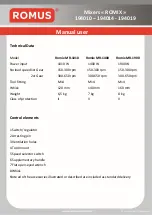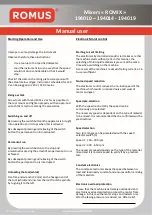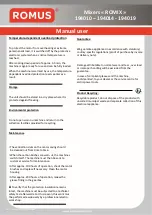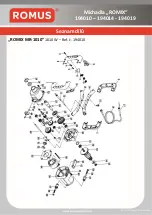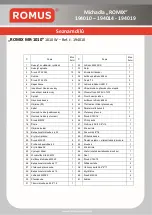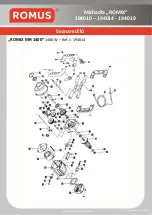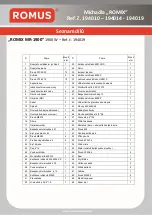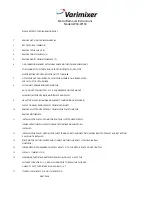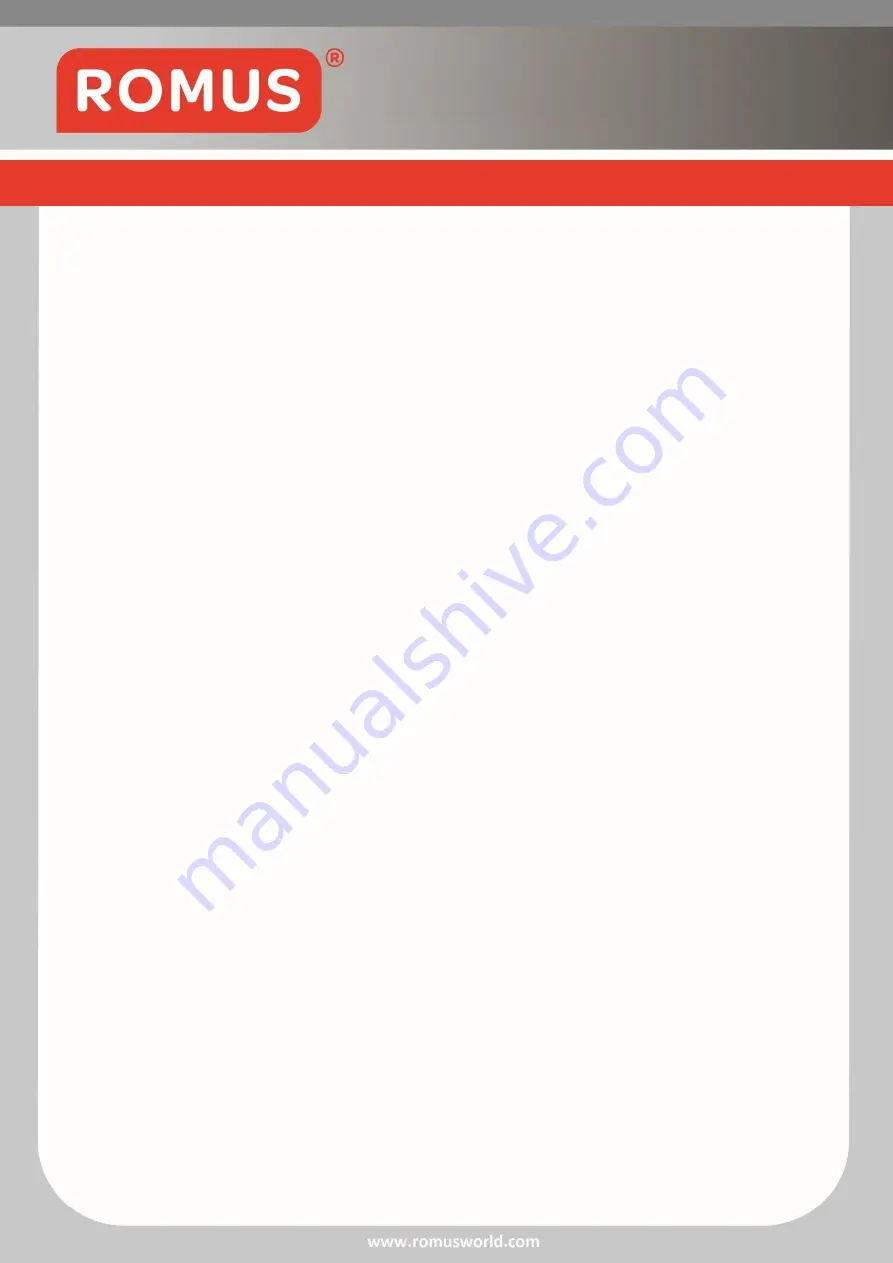
Mode
d’emploi
Mixers « ROMIX »
194010
–
194014 - 194019
Manual user
Safety instructions:
Keep all warnings and instructions for future reference.
The term "tool" in warnings refers to your power-operated
power tool (with power cord) or your battery-powered tool
(cordless).
1-
Work Area:
Keep work area clean and well lit. Disordered and dark areas are
conducive to accidents.
Do not operate power tools in explosive atmospheres, for
example in the presence of flammable liquids, gases or dust.
Power tools produce sparks that can ignite dust or smoke.
Keep children and others away when using the tool. Distractions
can cause you to lose control of the tool.
2-
Electrical safety:
The plugs of the power tool must be fitted to the base. Never
modify the plug in any way. Do not use adapters with grounded
tools. Unmodified plugs and suitable sockets will reduce the risk
of electric shock.
Avoid body contact with grounded surfaces such as pipes,
radiators, stoves and refrigerators. There is an increased risk of
electric shock if your body is grounded.
Do not expose tools to rain or moist conditions. Penetrating
water inside a tool will increase the risk of electric shock.
Do not abuse the cord. Never use the cord to carry, pull or
unplug the tool. Keep cord away from heat, lubricants, sharp
edges or moving parts. Damaged or tangled cords increase the
risk of electric shock.
When using a tool outdoors, use a suitable extension for
outdoor use. Using a cord suitable for outdoor use reduces the
risk of electric shock.
If using a tool in a damp and unavoidable location, use a
residual current device (RCD) protected power supply. The use
of an RCD reduces the risk of electric shock.
3-
Safety of persons:
Stay alert, watch what you are doing and use common sense
when using the tool. Do not use a tool when you are tired or
under the influence of drugs, alcohol or medication. A moment
of inattention while using a tool may result in serious injury to
persons
Use safety equipment. Always wear eye protection. Safety
equipment such as dust masks, non-slip safety shoes, helmets
or acoustic protections used for appropriate conditions will
reduce personal injury.
Avoid inadvertent starting. Make sure the switch is turned off
before connecting the tool to the mains and / or battery pack,
pick it up or carry it. Wearing tools with your finger on the
switch or connecting tools with the switch in the on position is a
source of accidents.
Remove any adjustment wrench before starting the tool. A
wrench left attached to a rotating part of the tool can cause
personal injury.
Do not rush. Maintain appropriate position and balance at all
times. This allows better control of the tool in unexpected
situations.
Dress appropriately. Do not wear loose clothing or jewelry. Keep
hair, clothing and gloves away from moving parts. Loose clothing,
jewelry or long hair can be caught in moving parts.
If devices are provided for the connection of equipment for dust
extraction and recovery, ensure that they are connected and
properly used. The use of these devices can reduce the risk of
dust.
4-
Use and maintenance of the tool:
Do not force the tool. Use the right tool for your application. The
adapted tool will perform better and safer work at the speed for
which it was built
Do not use the tool if the switch does not allow switching from
ON to OFF and vice versa. Any tool that can not be controlled by
the switch is dangerous and must be repaired.
Disconnect the plug from the power source and / or the battery
pack of the tool before adjusting, changing accessories, or before
storing the tool. Such preventive safety measures reduce the risk
of accidental starting of the tool.
Keep tools out of the reach of children and do not allow persons
not familiar with the tool or these instructions to operate it. Tools
are dangerous in the hands of novice users
Observe the maintenance of the tool. Check for misalignment or
blockage of moving parts, broken parts or any other condition
that may affect the operation of the tool. In case of damage, have
the tool serviced before use. Many accidents are due to poorly
maintained tools.
Keep sharp and clean cutting tools. Maintenance tools to cut
properly with sharp cutting parts are less likely to block and are
easier to control
Use the tool, accessories and blades etc. in accordance with these
instructions and in the manner specified for the particular type of
tool, taking into account the working conditions and the work to
be performed. Using the tool for operations other than those
provided could result in hazardous situations.
5-
Maintenance:
Have the tool serviced by a qualified service technician using only
identical replacement parts. This will ensure the safety of the
tool.
13-15 rue Taillefer 91160 Champlan
















